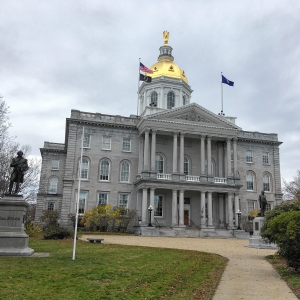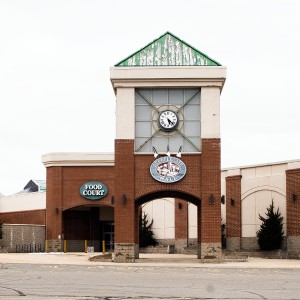Conway Lake landowners to restore cut trees

A photo of a property on Mudgett Road on Conway Lake. The town alleges the owners removed shrubbery and small trees from the property which should be replanted. Zoning Officer Nick DeVito told the Sun the town would like to see bushes planted there and trees planted on the other side of the berm to prevent erosion. —Courtesy
| Published: 04-30-2024 9:56 AM |
Owners of a parcel at Conway Lake are facing possible fines for allegedly cutting down trees within the 50-foot shoreline buffer zone.
One owner said they were just trying to clear out dead trees from their property and have agreed to replant some trees.
On Dec. 1, 2023, Conway zoning officer Nicholas DeVito had sent a violation notice to Marco Ciampa in Arlington, Mass., about cutting trees too close to the lakefront at his property on Mudgett Road in Center Conway.
The letter, which is part of the public record, was also addressed to Glenda Gonzalez, an co-owner of the property.
On March 17, DeVito sent Ciampa a letter asking for a remediation plan on March 18 and then sent a second notice April 22.
According to tax records, Ciampa and Glenda Gonzalez own about a quarter of an acre on Mudgett Road. In January the land was assessed at $415,400.
The letter from the town to Ciampa said: “The shoreland buffer zone is a critical area designated for the protection of water quality, aquatic habitat and overall ecological balance of our water front areas. As such, any disturbance within this zone can have significant environmental repercussions.
“Upon inspection, it has been observed that the cutting that occurred on your property has encroached on this buffer zone. This activity not only poses a threat to the natural ecosystem but also violates the regulations set forth by Conway Code 190-27 F.”
Article continues after...
Yesterday's Most Read Articles
 Youth rally against New Hampshire’s bill allowing medical aid in dying
Youth rally against New Hampshire’s bill allowing medical aid in dying
 As site testing begins on new middle school site, activists file to put location debate on the ballot
As site testing begins on new middle school site, activists file to put location debate on the ballot
 Lawyers and lawmakers assert the Department of Education is on the verge of violating the law
Lawyers and lawmakers assert the Department of Education is on the verge of violating the law
 A May tradition, the Kiwanis Fair comes to Concord this weekend
A May tradition, the Kiwanis Fair comes to Concord this weekend
 Neighboring landowner objection stalls Steeplegate redevelopment approval
Neighboring landowner objection stalls Steeplegate redevelopment approval
 State senator passes out on senate floor
State senator passes out on senate floor
DeVito asked Ciampato provide a remediation plan certified by a professional arborist to restore the property to its original condition. That plan is due June 20.
“Failure to comply with this request may result in further enforcement actions, including fines and penalties as per state statute,” said DeVito.
In an email Wednesday, DeVito told the Sun, “Regarding fines, our primary objective is to resolve matters amicably with property owners. Ideally, we aim to avoid fines altogether.
“However, should the situation necessitate it, the initial offense dates back to March 18, with subsequent offenses occurring on March 19 and each day thereafter. The fine for the initial offense is $275, with subsequent offenses incurring a $550 penalty each.”
On Thursday, DeVito said, “From the evidence available, it’s challenging to ascertain the exact number of trees that were removed. However, upon examining the stumps, I estimate that three to four small to medium-sized trees were indeed taken down.
“In light of this, the town has advised the replanting of four trees, each with a trunk diameter exceeding three inches, and to add five blueberry bushes along the shoreline. This recommendation aligns with our primary goal of preserving the berm and reinstating the vegetative buffer zone. It’s worth noting that these numbers aren’t arbitrary; rather, they adhere to the point system outlined by NHDES.”
On Thursday, DeVito said, “We have made contact with the property owners and they have agreed to the remediation plan.”
Reached by phone, Gonzalez, who also lives in Arlington, Mass., said she was unaware of the town’s letters. She said they had hired someone to remove dead trees. She also said the last letter they received was in February from the state Department of Environmental Services saying they inspected the property and there were no violations of the Shoreland Water Quality Protection Act.
Gonzalez said they are planning to put in a path and a dock by the lake.
“We were just removing logs,” she said. “We worked with the state and they looked and they gave us official notice saying there were no violations that were committed ... We just wanted to clean up.”
Gonzales said she would follow up with DeVito. “We want to make sure we want to do everything by the book,” she said.
Conway Code 190-27 F says: “There shall be a 50-foot-wide vegetated buffer along the water frontage of each lot. This buffer serves as a natural filter to protect the lakes from contaminated surface runoff, provides habitat for terrestrial wildlife, protects aesthetic qualities of the lake environment and helps prevent erosion of the shoreline.”
According to the zoning code, the following restrictions apply to the buffer:
• One access path across the buffer, up to 10 feet in width (measured parallel to the shoreline) is allowed for each 150 feet of water frontage.
• No vegetation less than 4 inches in diameter, measured at 4½ feet above ground level, shall be cut, trimmed, pruned or removed, except to provide for permitted access paths.
• For vegetation 4 inches or more in diameter, measured 4½ feet above ground level (trees), no more than 10 percent of the basal area of trees may be removed from the buffer (not including the area of permitted access paths) in any five-year period.
• Before any cutting may occur, the zoning officer shall be provided with a plat indicating the size and location of all trees in the buffer.
• Cutting may occur only after receipt of written authorization from the zoning officer.
• Dead trees and dead limbs may be cut down upon written authorization from the zoning officer.







 Barrington entrepreneur giving new life to single-use plastic
Barrington entrepreneur giving new life to single-use plastic For the first time, education commissioner speaks publicly about minimum standards revision, but he faces skepticism
For the first time, education commissioner speaks publicly about minimum standards revision, but he faces skepticism Adam Montgomery sentenced to minimum 56 years on murder charges in young daughter’s death
Adam Montgomery sentenced to minimum 56 years on murder charges in young daughter’s death
